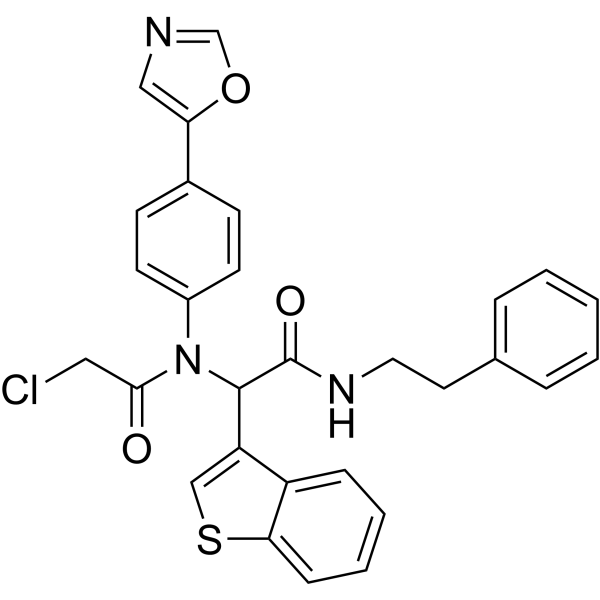Physicochemical Properties
| Molecular Formula | C29H24CLN3O3S |
| Molecular Weight | 530.03716468811 |
| Exact Mass | 529.122 |
| CAS # | 2761004-85-5 |
| PubChem CID | 162395709 |
| Appearance | White to off-white solid powder |
| LogP | 6 |
| Hydrogen Bond Donor Count | 1 |
| Hydrogen Bond Acceptor Count | 5 |
| Rotatable Bond Count | 9 |
| Heavy Atom Count | 37 |
| Complexity | 759 |
| Defined Atom Stereocenter Count | 0 |
| SMILES | ClCC(N(C1C=CC(C2=CN=CO2)=CC=1)C(C(NCCC1C=CC=CC=1)=O)C1=CSC2C=CC=CC1=2)=O |
| InChi Key | ZLCPSXKEQBUXRJ-UHFFFAOYSA-N |
| InChi Code | InChI=1S/C29H24ClN3O3S/c30-16-27(34)33(22-12-10-21(11-13-22)25-17-31-19-36-25)28(24-18-37-26-9-5-4-8-23(24)26)29(35)32-15-14-20-6-2-1-3-7-20/h1-13,17-19,28H,14-16H2,(H,32,35) |
| Chemical Name | 2-(1-benzothiophen-3-yl)-2-[N-(2-chloroacetyl)-4-(1,3-oxazol-5-yl)anilino]-N-(2-phenylethyl)acetamide |
| HS Tariff Code | 2934.99.9001 |
| Storage |
Powder-20°C 3 years 4°C 2 years In solvent -80°C 6 months -20°C 1 month |
| Shipping Condition | Room temperature (This product is stable at ambient temperature for a few days during ordinary shipping and time spent in Customs) |
Biological Activity
| ln Vitro | GPX4-IN-3 (26a) has IC50 values of 0.78 μM, 6.9 μM, 0.15 μM, and 4.73 μM against 4T1, MCF-7, HT1080, and HT1080 (containing Fer-1) cells, respectively [1]. GPX4-IN-3 (26a) demonstrates remarkable GPX4 inhibitory efficacy, demonstrating an inhibition percentage of up to 71.7% at 1.0 μM, in contrast to RSL-3's 45.9%[1]. GPX4-IN-3 (26a) shows good selectivity, increases lipid peroxide (LPO) dramatically, and promotes ferroptosis efficiently [1]. By suppressing GPX4 activity, GPX4-IN-3 (26a) is more likely to cause ferroptosis by accumulating intracellular superoxide [1]. In 4T1 cells, GPX4-IN-3 (26a) dramatically raises ferrostatin-1 (fer-1) and reverses ROS levels [1]. |
| ln Vivo | In vivo, GPX4-IN-3 (26a) exhibits strong anti-tumor efficacy and good biosafety [1]. |
| Animal Protocol |
Animal/Disease Models: Mouse 4T1 xenograft model[1]. Doses: 15 and 30 mg/kg. Route of Administration: intravenous (iv)injection, every two days for a total of five times. Experimental Results: Dramatically suppress tumor growth with a tumor growth inhibition (TGI) value of 33.2 and 55.1% at 15 and 30 mg/kg, respectively. |
| References |
[1]. Discovery of a Potent Glutathione Peroxidase 4 Inhibitor as a Selective Ferroptosis Inducer. J Med Chem. 2021 Sep 23;64(18):13312-13326. |
Solubility Data
| Solubility (In Vitro) | DMSO : 67.5 mg/mL (127.35 mM) |
| Solubility (In Vivo) |
Solubility in Formulation 1: 6.75 mg/mL (12.73 mM) in 10% DMSO + 90% (20% SBE-β-CD in Saline) (add these co-solvents sequentially from left to right, and one by one), suspension solution; with sonication. For example, if 1 mL of working solution is to be prepared, you can add 100 μL of 67.5 mg/mL clear DMSO stock solution to 900 μL of 20% SBE-β-CD physiological saline solution and mix evenly. Preparation of 20% SBE-β-CD in Saline (4°C,1 week): Dissolve 2 g SBE-β-CD in 10 mL saline to obtain a clear solution. Solubility in Formulation 2: ≥ 6.75 mg/mL (12.73 mM) (saturation unknown) in 10% DMSO + 90% Corn Oil (add these co-solvents sequentially from left to right, and one by one), clear solution. For example, if 1 mL of working solution is to be prepared, you can add 100 μL of 67.5 mg/mL clear DMSO stock solution to 900 μL of corn oil and mix evenly. (Please use freshly prepared in vivo formulations for optimal results.) |
| Preparing Stock Solutions | 1 mg | 5 mg | 10 mg | |
| 1 mM | 1.8867 mL | 9.4333 mL | 18.8665 mL | |
| 5 mM | 0.3773 mL | 1.8867 mL | 3.7733 mL | |
| 10 mM | 0.1887 mL | 0.9433 mL | 1.8867 mL |
